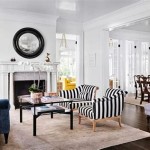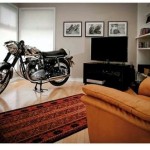```html
How To Decorate An Open Concept Living Room And Kitchen
Open concept living spaces, combining the living room and kitchen into a single, expansive area, present both exciting opportunities and unique challenges when it comes to decoration. Successfully decorating an open concept living room and kitchen requires careful planning, a cohesive design approach, and a keen understanding of how to create distinct zones within a unified space. The aim is to achieve a harmonious balance between functionality, aesthetics, and flow, ensuring that the space feels both inviting and practical.
One of the primary considerations is establishing a consistent design language. This involves selecting a color palette, style of furniture, and types of materials that will be used throughout both areas. A well-defined design language ensures that the open concept space feels integrated and intentional, rather than disjointed. This doesn't necessarily mean everything must match perfectly, but there should be a clear sense of continuity and coherence between the living room and kitchen elements.
The use of strategic layouts is also crucial. Furniture placement, island positioning, and the arrangement of accessories can all play a significant role in defining different zones within the open concept space. This allows for the creation of distinct areas for cooking, dining, relaxing, and socializing, without compromising the overall sense of openness. Thoughtful planning, considering both functional needs and traffic flow, is essential for maximizing the usability and enjoyment of the space.
Before embarking on the decorating process, it's beneficial to assess the existing architectural features of the space. Consider the natural light sources, the placement of windows and doors, and any existing built-in elements. These features can serve as inspiration for the overall design and inform decisions about furniture placement, color schemes, and the selection of decorative accents. Working with the existing architectural elements, rather than against them, can enhance the overall aesthetic appeal of the space and create a more harmonious interior.
Establishing a Cohesive Design Language
The foundation of a successful open concept décor lies in establishing a cohesive design language. This means selecting a consistent color palette, style, and material choices that are reflected throughout both the living room and kitchen areas. This consistent design language fosters a sense of unity and visual flow, preventing the space from feeling fragmented.
The color palette should be carefully considered, aiming for a balance between complementary and contrasting colors. A neutral base palette, such as whites, grays, or beiges, can provide a versatile backdrop for both the living room and kitchen. Accent colors can then be introduced through furniture, accessories, and artwork, adding visual interest and personality to the space. It’s important to ensure that the accent colors are used consistently and strategically throughout the open concept area to maintain a sense of cohesion.
The style of furniture should also be consistent with the overall design language. If opting for a modern aesthetic, sleek and minimalist furniture pieces would be appropriate. Conversely, a more traditional style might favor upholstered furniture with classic lines and details. The key is to ensure that the furniture choices in both the living room and kitchen complement each other and contribute to the overall design vision.
Material choices also play a crucial role in establishing a cohesive design language. Selecting materials with similar textures, finishes, and tones can create a sense of visual harmony. For example, if the kitchen features stainless steel appliances, incorporating metallic accents in the living room, such as in lighting fixtures or decorative objects, can help to tie the two spaces together. Similarly, if the kitchen countertops are made of granite, considering using granite or a similar stone element in the living room, such as for a fireplace surround or coffee table, can further enhance the sense of cohesion.
Consider the flooring as a unifying element. If possible, using the same flooring throughout the entire open concept area creates a seamless transition between the living room and kitchen. If different flooring materials are desired for practical reasons, such as tile in the kitchen and hardwood in the living room, ensure that the materials complement each other in terms of color, texture, and style.
Defining Zones with Strategic Layouts
While maintaining an open and flowing feel is essential in an open concept space, it's equally important to define distinct zones for different activities. This can be achieved through strategic furniture placement, the use of area rugs, and the incorporation of architectural elements.
Furniture placement is a key factor in defining zones. For instance, a large sectional sofa can delineate the living room area, while a kitchen island can serve as a natural divider between the cooking and dining zones. The placement of furniture should also consider traffic flow, ensuring that there is ample space for movement between different areas of the open concept space. Avoiding obstructions and creating clear pathways will enhance the usability and enjoyment of the space.
Area rugs are another effective tool for defining zones. An area rug placed under the living room seating area can visually anchor the space and create a sense of intimacy. Similarly, a rug placed under the dining table can define the dining area and add warmth and texture to the space. The rugs should be appropriately sized for the respective areas and should complement the overall color palette and style of the décor.
The kitchen island often serves as a central focal point and a natural divider within an open concept space. Its placement should be carefully considered to optimize functionality and flow. The island can provide additional counter space for food preparation, seating for casual dining, and storage for kitchen essentials. Its design should be consistent with the overall style of the kitchen and should complement the surrounding furniture and décor.
Architectural elements, such as partial walls, columns, or changes in ceiling height, can also be used to define zones within an open concept space. These elements can provide a subtle visual separation between different areas without completely closing them off. For example, a partial wall can separate the kitchen from the living room while still allowing for visual connection and natural light to flow through. Similarly, a change in ceiling height can create a sense of separation between the dining area and the living room.
Lighting plays a vital role in defining zones. Strategic lighting can highlight specific areas and create different moods within the open concept space. For example, recessed lighting can be used to illuminate the kitchen area, while pendant lights can be hung over the kitchen island to provide task lighting. In the living room, a combination of ambient lighting, task lighting, and accent lighting can be used to create a warm and inviting atmosphere. Dimmers can be installed to adjust the lighting levels and create different moods for different occasions.
Integrating Functionality and Aesthetics
Decorating an open concept living room and kitchen requires a careful integration of functionality and aesthetics. The space should be both visually appealing and practical, catering to the needs of daily life while reflecting the personal style of the occupants.
Storage solutions are paramount in an open concept space, particularly in the kitchen area. Maximizing storage space helps to keep the area organized and clutter-free, which is essential for maintaining a sense of calm and order. Consider incorporating clever storage solutions, such as pull-out drawers, built-in cabinets, and pantry organizers, to make the most of the available space.
In the living room, choose furniture that is both comfortable and functional. A sectional sofa with built-in storage can provide ample seating and storage for blankets, pillows, and other items. A coffee table with storage drawers or shelves can also be a practical addition to the living room, providing a place to store books, magazines, and remote controls.
Consider the acoustics of the open concept space. Hard surfaces, such as hardwood floors and tile countertops, can reflect sound and create an echoey environment. Incorporating soft materials, such as rugs, curtains, and upholstered furniture, can help to absorb sound and improve the acoustics of the space. Acoustic panels can also be installed on the walls or ceiling to further reduce noise levels.
Artwork and accessories can add personality and visual interest to the open concept space. Choose artwork that complements the overall color palette and style of the décor. Consider incorporating a variety of textures, shapes, and sizes to create a visually dynamic display. Accessories, such as vases, candles, and decorative objects, can be used to add pops of color and personality to the space. Avoid cluttering the space with too many accessories, as this can detract from the overall sense of openness and harmony.
Greenery can also enhance the overall aesthetic appeal of the open concept space. Plants can add life, color, and texture to the interior, while also helping to purify the air. Consider incorporating a variety of plants, such as potted plants, hanging plants, and succulents, into the décor. Choose plants that are appropriate for the lighting conditions and the overall style of the space.
Ultimately, decorating an open concept living room and kitchen is about creating a space that is both beautiful and functional. By carefully considering the design language, layout, and integration of functionality and aesthetics, it is possible to create a harmonious and inviting space that meets the needs of daily life and reflects the personal style of the occupants.
```
Stunning Open Concept Living Room Ideas

Open Concept Kitchen Ideas And Layouts

17 Open Concept Kitchen Living Room Design Ideas Style Motivation

Open Concept Kitchen And Living Room Décor Modernize

15 Open Concept Kitchens And Living Spaces With Flow

How To Decorate An Open Plan Kitchen Living Room Colourland

How To Decorate An Open Plan Kitchen Living Room Dulux

Before After Open Concept Kitchen And Living Room Decorilla Interior Design

Stunning Open Concept Living Room Ideas

31 Open Kitchen And Living Room Design
Related Posts







